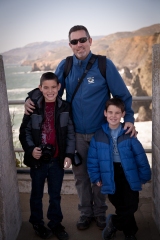- Forum
- General Discussion | Introductions | Off Topic Forum
- Photography General Discussion
- Exposure compensation question
Exposure compensation question
-
 Topic Author
Topic Author
- John37
- The Lounger
-
- Canon 5Dc & 5D mkii
- Followers: 25
- Posts: 1070
-
Points:
0
Post #226904
"The most endangered species? The honest man!"
Post #226917
For the second part, I'm not sure what you mean by EC changing the shutter speed being "a wash". Changing the shutter speed is what I would expect EC to do when in Av mode. Remember that EC is a way to compensate for your meter giving you the "wrong" readings due to the scene being brighter or darker than an 18% gray card.
-Matt
-
 Topic Author
Topic Author
- John37
- The Lounger
-
- Canon 5Dc & 5D mkii
- Followers: 25
- Posts: 1070
-
Points:
0
Post #226922
"The most endangered species? The honest man!"
Post #226925
Or maybe you could put the camera on a tripod with a pan head? Or maybe flash? If either is feasible, that may help.
-Matt
-
 Topic Author
Topic Author
- John37
- The Lounger
-
- Canon 5Dc & 5D mkii
- Followers: 25
- Posts: 1070
-
Points:
0
Post #226929
Thanks, Matt!
"The most endangered species? The honest man!"
-

- CWphotos
- Photography Hooked
-
- Canon 5D, Pentax K10D & Pentax ist DS
- Followers: 74
- Posts: 521
-
Points:
10
Post #226932
What you are is so loud, I can't hear a word you say!
-

- KCook
- Photo Elder
-
- Canon EOS 50D and Olympus E-P5
- Followers: 1325
- Posts: 5410
-
Points:
32913
Post #226964
www.photographytalk.com/photography-arti...basics-of-exposure-4
shutterfinger.typepad.com/shutterfinger/...ion-of-exposure.html
laurencekim.com/2009/12/20/your-camera-lies/
neilvn.com/tangents/exposure-metering/exposure-compensation/
Kelly Cook
-
 Topic Author
Topic Author
- John37
- The Lounger
-
- Canon 5Dc & 5D mkii
- Followers: 25
- Posts: 1070
-
Points:
0
Post #226992
So here's what I picture in my head. I'm at a concert, the lighting is dim, and I'm using Av mode with no flash. My shutter has to stay at 60, for the sake of argument. But when I point my camera at my subject it says 30. So I adjust my EC to one full stop of over-exposure. I point my camera at something brighter to make it think it needs to be a 60th of a second. Then, I lock that exposure in and take the shot. As my ambient exposure is now 1 stop low, wouldn't the EC being 1 stop up compensate for that? Is that techincally right?
I've got to be missing something obvious... as usual.
Thanks for the links, Kelly. I'll have a look at those.
"The most endangered species? The honest man!"
-

- KCook
- Photo Elder
-
- Canon EOS 50D and Olympus E-P5
- Followers: 1325
- Posts: 5410
-
Points:
32913
Post #227009
Kelly
Post #227023
John37 wrote: The fact that I'm losing everyone with this tells me I'm the one that's lost!!!
So here's what I picture in my head. I'm at a concert, the lighting is dim, and I'm using Av mode with no flash. My shutter has to stay at 60, for the sake of argument. But when I point my camera at my subject it says 30. So I adjust my EC to one full stop of over-exposure. I point my camera at something brighter to make it think it needs to be a 60th of a second. Then, I lock that exposure in and take the shot. As my ambient exposure is now 1 stop low, wouldn't the EC being 1 stop up compensate for that? Is that techincally right?
I've got to be missing something obvious... as usual.
Thanks for the links, Kelly. I'll have a look at those.
If you did as you described you would be underexposing your picture by one stop.
-Matt
-

- CWphotos
- Photography Hooked
-
- Canon 5D, Pentax K10D & Pentax ist DS
- Followers: 74
- Posts: 521
-
Points:
10
Post #227024
John37 wrote: The fact that I'm losing everyone with this tells me I'm the one that's lost!!!
So here's what I picture in my head. I'm at a concert, the lighting is dim, and I'm using Av mode with no flash. My shutter has to stay at 60, for the sake of argument. But when I point my camera at my subject it says 30. So I adjust my EC to one full stop of over-exposure. I point my camera at something brighter to make it think it needs to be a 60th of a second. Then, I lock that exposure in and take the shot. As my ambient exposure is now 1 stop low, wouldn't the EC being 1 stop up compensate for that? Is that techincally right?
I've got to be missing something obvious... as usual.
Thanks for the links, Kelly. I'll have a look at those.
If I am wrong, I appologize ahead of time!
What you are is so loud, I can't hear a word you say!
-

- Henry Peach
- Apprentice
-
- I currently use a 5DII or Sony Nex-3 most of the time.
- Followers: 50
- Posts: 2925
-
Points:
16
Post #227099
John37 wrote: 1st, if you use exposure compensation to the brightest setting, will it cause more noise to the image?
EC adjusts what tone the meter is going for. It should tend to over expose, but it depends entirely on what you are metering. If EC is set to +3, and you meter middle gray, it's going to give you the settings to make middle gray 3 stops brighter. If EC is set to +3, and you meter something 3 stops brighter than middle gray it's going to give you the settings to make middle gray middle gray. If you meter something 1 stop brighter than middle gray it will make middle gray 2 stops brighter. If you meter something 1 stop darker than middle gray it will make middle gray 4 stops brighter.
John37 wrote: But, I can trick the camera by locking the exposure to a higher shutter speed by pointing to a lighter source, with EC all the way up. Would this be worth doing, in trying to keep the noise level down?
Noise is going to have to be assessed individually. At what point noise caused by under exposure becomes an issue is part opinion, but also will vary depending on the camera and processing.
Meter lock allows you to meter an area and then recompose without the meter re-adjusting. It's handy when the tone you'd like to make middle gray (or whatever the meter is going for via exposure comp) isn't in the center of your viewfinder.
You are succumbing to the idea that gizmos will make your job easier, but as your meltdown demonstrates they often make things more difficult. Here's how I would go about shooting the concert situation described above. Leave EC to zero. Take a test shot. I'd probably pick an exposure based on experience, but I could just zero the meter or put the camera on an auto mode such as Av. Check the histogram to assess the exposure. Adjust from there. Unless the lighting varies or is uneven across the stage I can just shoot away. If the lighting does change then I might take several test shots, and figure out the settings for those conditions. For instance maybe the edges of the stage are 1.3 stops dimmer than the center, and reduce exposure by 2 stops when the main spotlight is on, etc.... Or I could set the meter mode to spot, and adjust exposure so that the performers faces meter at +1 stop for light skin and middle gray for dark skin. Unless the scene is very even tonally operating in manual exposure is probably going to require less effort and concentration than babysitting the meter. With a little practice you will become very fast at adjusting settings manually.
-

- Henry Peach
- Apprentice
-
- I currently use a 5DII or Sony Nex-3 most of the time.
- Followers: 50
- Posts: 2925
-
Points:
16
Post #227102
John37 wrote: As my ambient exposure is now 1 stop low, wouldn't the EC being 1 stop up compensate for that?
Exposure compensation adjusts what tone the meter goes for in any auto exposure mode.
When you say "ambient exposure is now 1 stop low" do you mean 1 stop less than middle gray? Or 1 stop less than middle gray +1?
Is the ambient light background middle gray? If it is dim it should meter less than middle gray.
Proper exposure is an opinion. The meter helps you determine how much light you have to work with, but what exposure and processing results in the "right" tones is up to you.
-
 Topic Author
Topic Author
- John37
- The Lounger
-
- Canon 5Dc & 5D mkii
- Followers: 25
- Posts: 1070
-
Points:
0
Post #227149
"The most endangered species? The honest man!"
-

- KCook
- Photo Elder
-
- Canon EOS 50D and Olympus E-P5
- Followers: 1325
- Posts: 5410
-
Points:
32913
Post #227166
A common occurrence indoors. Instead of sweating buckets of blood trying to keep the ISO down, I focus on NR techniques in post. Of course in the perfect world I would just run out and buy the latest, greatest body.ISO had to be tapped hard
Kelly
- Forum
- General Discussion | Introductions | Off Topic Forum
- Photography General Discussion
- Exposure compensation question
Latest Reviews
The Panasonic G9 II is a 25.2-megapixel micro four thirds camera with numerous features that make it punch out of its weight class, like 779 AF points, 5.8K video, and weather sealing.
The Fujifilm XT5 is a 40MP mirrorless camera capable of 6.2K video at 30p. With those specs, it’s an ideal choice for photographers needing a camera to pull double duty for imaging and video.
The Canon EOS R100 is an entry-level mirrorless camera introduced in 2023. But just because it’s an entry-level camera doesn’t mean it’s a bare-bones camera. Find out why in this review!
Nikon’s retro-looking Nikon Zfc is anything but retro. Under its classic body is a host of features and amenities that make it a worthwhile compact mirrorless camera for 2024.
Forum Top Posters
-
1TCav 7 posts
-
2Ruby Grace 4 posts
-
3Garbo 3 posts
-
4Street Shark 3 posts
-
5amirahusse... 2 posts
-
6CharleyL 2 posts
-
7Carter Gledhill 2 posts
-
8Sassy Girl 2 posts
-
9Chester Foster 2 posts
-
10Colorado Mike 2 posts
Latest Articles
The Panasonic G9 II is a 25.2-megapixel micro four thirds camera with numerous features that make it punch out of its weight class, like 779 AF points, 5.8K video, and weather sealing.
Cinematic photography is an interesting genre that combines photographic and videographic skills along with effective storytelling techniques. The result? Highly impactful images!
Newborn photography requires skill, the right gear, and a lot of patience. This beginner’s guide discusses critical topics that will help you be more prepared for before, during, and after the shoot.
To fill the frame means to expand the footprint of the subject in your shot. Get in close, zoom in, crop the image, or use other techniques to bring the subject to the forefront.
With these simple yet effective beginner photography tips, you can avoid some of the common mistakes beginners make and get improved results with your images.
Urban photography is a genre showcasing features in urban settings. You can photograph people, architecture, mass transit, and many other subjects. Learn how to do so in this guide!
The Nikon D850 might be an older DSLR, but it was ahead of its time when it debuted in 2017. That means it still has plenty of firepower to compete with today’s powerful mirrorless cameras.
The best beginner camera isn’t the same for everyone. That means having choice is of the utmost importance. In this guide, explore five excellent beginner camera options for 2024 and beyond.















